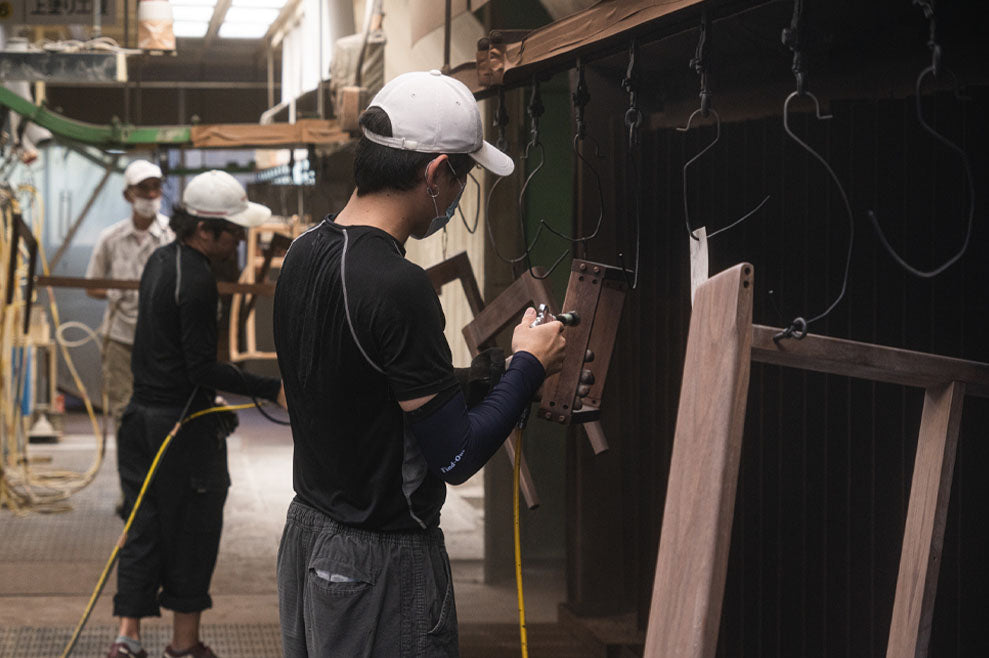
Karimoku Cat: Part Two - The Art of Crafting Cat Trees
In the second instalment of our series on Karimoku Cat, we're immersing ourselves in the intricacies of their manufacturing process. Building upon the heritage and products explored in Part One, we now turn our attention to the remarkable craftsmanship behind these exquisite cat trees.
Karimoku Cat's Triple-Paint Process
Karimoku Cat Trees undergo three rounds of sanding and painting, ensuring the highest quality finish.
A Coat of Protection: Varnishing Wood Cat Trees
At the core of Karimoku Cat's commitment to quality lies the art of wood varnishing. Why is varnishing essential, you might ask? Simply put, it's the guardian that bestows longevity upon the wood, preserving its beauty for years to come. Varnish comes in two primary categories: synthetic and natural.
Synthetic Marvels: Polyurethane, Polyester, and Lacquer
Let's begin with synthetic varnishes, where innovation meets durability. In the world of wood furniture, three synthetic titans reign supreme: Polyurethane, Polyester, and Lacquer.
Polyurethane stands tall as the most globally embraced varnish, and Karimoku Cat employs it meticulously on their oak and walnut cat trees. The reason? Polyurethane boasts an impressive array of properties. Its unyielding hardness, resistance to heat and UV rays, waterproof nature, and resilience against dirt and alcohol make it the ultimate guardian of wood. Keep in mind that this remarkable varnish is region-specific, setting it apart from European counterparts, where synthetic paints are less prevalent.

Polyurethane Is Used by Karimoku Cat © 2021 Tomooki Kengaku
Why are other varnishes less suitable for Karimoku Cat Trees, you might wonder? Let's delve into the reasons.
Polyester varnish, typically found on pianos, is exceptionally hard and challenging to remove through sanding. In contrast, lacquer offers a glossy finish but lacks durability, making it suitable for instruments like guitars, yet prone to breakage if dropped.
On the other hand, Urushi stands as the most effective varnish globally for furniture. This Japanese varnish, derived from tree sap, boasts unparalleled quality. Its distinctive wet and shiny appearance, however, comes at a high cost due to the limited availability of the trees producing it. Furthermore, harvesting Urushi sap is a meticulous process, as extracting excessive quantities over time can harm and even kill the source tree.
While synthetic varnishes dominate the landscape, nature has its own offerings. Oil varnish, unlike its synthetic counterparts, permeates the wood, nourishing it from within. However, it lacks the protective layer that sits atop the wood's surface, making it less effective in safeguarding cat trees against wear and tear.
On the other hand, soap varnish, known for its wax-like, non-reflective finish, demands high maintenance. This varnish thrives on Danish furniture, beautifully complementing white woods but requiring diligent care.
Oak has pores/vessels that carry water through the tree. Karimoku Cat intentionally keeps these pores open, enhancing the tactile and authentic feel of the wood surface.
Karimoku Cat's Meticulous Painting Process
The wood used in crafting Karimoku Cat Trees undergoes a two-step process. First, it is (1) precision machine-cut, followed by (2) meticulous hand sanding. This essential sanding process, entrusted to highly skilled artisans, serves as the preparation stage for varnishing. These skilled sanders progress through various areas within the company, applying their expertise in handling different wood types and sandpapers. The initial sanding takes place efficiently on a conveyor belt.

Hand Sanding © 2021 Tomooki Kengaku
The journey continues with (3) the application of a base colour that imparts a unique character to each piece. Karimoku offers an impressive palette of 15 colours, all inspired by the essence of wood. This transparent paint is applied in a specialised "Painting Booth," with flowing water that absorbs excess paint.

The Painting Booth © 2021 Tomooki Kengaku
To ensure a flawless finish, (4) the wood product is hung to dry. Precise holes are carved for hooks, always in areas that won't be visible, preserving the paint's integrity. A dedicated "Clean Room" serves as the sanctum for drying painted wood, ensuring no dust mars the final product. Temperature and humidity are carefully controlled to guarantee the optimal drying conditions.

Painted Furniture Drying in Karimoku's Clean Room © 2021 Tomooki Kengaku
(5) The wood undergoes another round of sanding for meticulous perfection. The initial sanding creates a fine wood powder that leaves a subtly rough surface, even after varnish application. While this powder may be invisible to the naked eye, Karimoku Cat's commitment to excellence demands a careful hand-sanding process, often conducted off the conveyor belt to ensure utmost precision. This stage typically takes about an hour to complete.

Hand Sanding at Karimoku © 2021 Tomooki Kengaku
(6) A subsequent layer of paint is skilfully applied. During this phase, the experienced craftsperson carefully fine-tunes the paint colour, ensuring it harmonizes perfectly with the desired shade. This precision is achieved through meticulous comparisons to reference samples, all done by the discerning eye of the artisan.
(7) Following this, the wood undergoes another round of sanding. This essential step is taken to further refine the wood's surface texture. Even after the application of the previous layers, the wood may still retain a subtle roughness. To achieve a flawless finish, Karimoku insists on this thorough sanding process.
(8) As the finishing touch, a final layer of transparent paint is applied. This last layer enhances the wood's natural beauty and provides an enduring protective finish. The combination of expert craftsmanship and attention to detail throughout these painting stages ensures that each Karimoku Cat Tree is a true masterpiece, worthy of its exceptional reputation.


